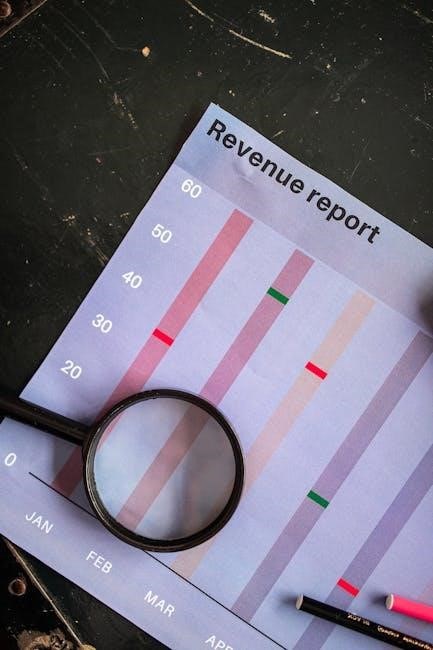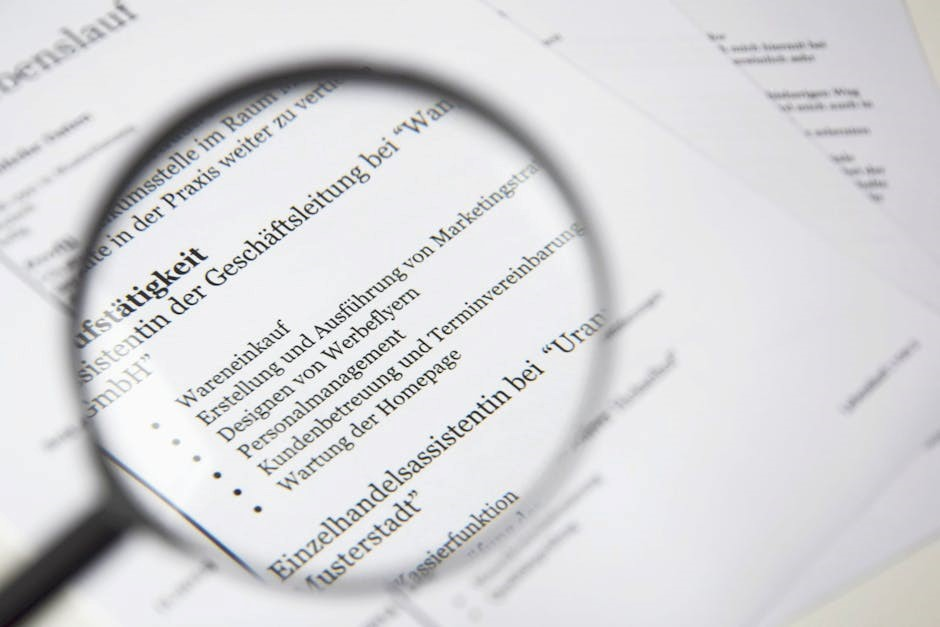An investigation report is a detailed document outlining the findings of an inquiry into an incident or allegation. It ensures accountability‚ provides clear insights‚ and supports decision-making processes. Organizations rely on structured formats to maintain consistency and professionalism in their reporting‚ making investigation reports indispensable in various fields.
1;1 Definition and Purpose
An investigation report is a structured document detailing the findings of an inquiry into an incident‚ allegation‚ or issue. Its primary purpose is to provide a clear‚ factual account of events‚ supporting decision-making and accountability. Standardized formats‚ such as PDF templates‚ ensure consistency and professionalism‚ making the report credible and easily accessible. The report serves as a formal record‚ enabling stakeholders to understand the situation‚ evaluate evidence‚ and implement appropriate actions based on the findings. It is essential for transparency and fairness in various contexts.

1.2 Importance in Various Fields
Investigation reports play a crucial role in multiple industries‚ ensuring transparency and accountability. In workplaces‚ they document incidents‚ preventing future occurrences. In criminal justice‚ they provide evidence for legal proceedings. Healthcare and academia rely on them for compliance and ethical standards. Standardized formats‚ like PDF templates‚ enhance professionalism and accessibility‚ making them indispensable tools for organizations to address issues systematically and maintain trust among stakeholders. Their versatility ensures they are adapted to meet the specific needs of different sectors effectively.

Key Sections of an Investigation Report
An investigation report typically includes an executive summary‚ purpose and scope‚ allegations summary‚ findings‚ analysis‚ conclusions‚ recommendations‚ and appendices. These sections ensure clarity and thoroughness.
2.1 Executive Summary
The executive summary provides a concise overview of the investigation‚ including key findings‚ conclusions‚ and recommendations. It serves as a snapshot‚ enabling quick understanding of the report’s critical aspects without delving into detailed content. This section is crucial for stakeholders seeking a high-level overview of the investigation’s outcomes and implications. It should be clear‚ factual‚ and free from jargon to ensure accessibility for all readers. The executive summary sets the stage for the detailed analysis presented in subsequent sections of the report. Properly crafted‚ it enhances the report’s effectiveness and credibility.
2.2 Purpose and Scope of Investigation
The purpose and scope of the investigation section outlines the objectives and boundaries of the inquiry. It clarifies why the investigation was conducted and what specific issues were examined. This section ensures the investigation remains focused and relevant‚ avoiding scope creep. It defines the key questions or allegations addressed‚ the timeframe considered‚ and the evidence reviewed. Clearly articulating the purpose and scope helps guide the investigation process and ensures all relevant matters are thoroughly addressed. This section is crucial for maintaining direction and efficiency in the inquiry. Properly defining the scope ensures that the investigation remains aligned with its intended goals. It also helps stakeholders understand the limits of the inquiry‚ preventing misunderstandings. By establishing clear parameters‚ the purpose and scope section provides a roadmap for the entire investigation‚ ensuring that all necessary areas are explored without unnecessary diversions. This clarity is essential for producing a comprehensive and effective report. The purpose and scope section sets the foundation for the investigation‚ ensuring that it is conducted in an organized and systematic manner. It is a critical component of any investigation report‚ as it provides the context and framework for the findings and recommendations that follow. By clearly defining the purpose and scope‚ the investigation team can ensure that their efforts are focused and productive‚ leading to a more accurate and reliable outcome. This section is vital for maintaining the integrity and credibility of the investigation process. It ensures that all stakeholders are aligned and that the investigation addresses the most critical aspects of the case. The purpose and scope section is a cornerstone of a well-structured investigation report‚ providing the necessary clarity and direction for a successful inquiry. It helps to establish expectations and ensures that the investigation is conducted in a fair and transparent manner. By carefully defining the purpose and scope‚ the investigation team can manage resources effectively and prioritize efforts on the most relevant areas. This section is essential for ensuring that the investigation is both thorough and efficient‚ leading to actionable insights and meaningful conclusions. The purpose and scope section is a fundamental part of any investigation report‚ as it provides the necessary framework for a systematic and effective inquiry. It ensures that the investigation is conducted with clear objectives and boundaries‚ leading to a more focused and productive process. By articulating the purpose and scope‚ the investigation team can ensure that all stakeholders are informed and that the inquiry is aligned with its intended goals. This section is critical for maintaining the integrity and effectiveness of the investigation‚ providing a clear roadmap for the entire process. It helps to ensure that the investigation is comprehensive‚ yet concise‚ and that all relevant factors are considered. The purpose and scope section is a key element of a well-structured investigation report‚ providing the necessary direction and focus for a successful outcome. It is essential for ensuring that the investigation is conducted in a systematic and organized manner‚ leading to accurate and reliable results. By clearly defining the purpose and scope‚ the investigation team can manage the inquiry effectively‚ ensuring that all critical aspects are addressed. This section is vital for maintaining the credibility and effectiveness of the investigation process. It provides the necessary clarity and direction‚ ensuring that the investigation is both thorough and efficient. The purpose and scope section is a cornerstone of a well-structured investigation report‚ offering a clear framework for a successful inquiry. It helps to establish expectations and ensures that the investigation is conducted in a fair and transparent manner. By carefully defining the purpose and scope‚ the investigation team can manage resources effectively and prioritize efforts on the most relevant areas. This section is essential for ensuring that the investigation is both thorough and efficient‚ leading to actionable insights and meaningful conclusions. The purpose and scope section is a fundamental part of any investigation report‚ as it provides the necessary framework for a systematic and effective inquiry. It ensures that the investigation is conducted with clear objectives and boundaries‚ leading to a more focused and productive process. By articulating the purpose and scope‚ the investigation team can ensure that all stakeholders are informed and that the inquiry is aligned with its intended goals. This section is critical for maintaining the integrity and effectiveness of the investigation‚ providing a clear roadmap for the entire process. It helps to ensure that the investigation is comprehensive‚ yet concise‚ and that all relevant factors are considered. The purpose and scope section is a key element of a well-structured investigation report‚ providing the necessary direction and focus for a successful outcome. It is essential for ensuring that the investigation is conducted in a systematic and organized manner‚ leading to accurate and reliable results. By clearly defining the purpose and scope‚ the investigation team can manage the inquiry effectively‚ ensuring that all critical aspects are addressed. This section is vital for maintaining the credibility and effectiveness of the investigation process. It provides the necessary clarity and direction‚ ensuring that the investigation is both thorough and efficient. The purpose and scope section is a cornerstone of a well-structured investigation report‚ offering a clear framework for a successful inquiry. It helps to establish expectations and ensures that the investigation is conducted in a fair and transparent manner. By carefully defining the purpose and scope‚ the investigation team can manage resources effectively and prioritize efforts on the most relevant areas. This section is essential for ensuring that the investigation is both thorough and efficient‚ leading to actionable insights and meaningful conclusions.
2.3 Allegations Summary
The allegations summary provides a clear overview of the complaints or issues under investigation. It briefly outlines the nature of the claims‚ identifying key parties involved and the specific concerns raised. This section ensures clarity and focus‚ allowing readers to understand the core matters being examined. The summary is supported by relevant details‚ such as dates‚ locations‚ and the basis for the allegations‚ providing a foundation for the subsequent investigation and analysis.
2.4 Findings and Evidence
The findings and evidence section details the results of the investigation‚ presenting facts objectively. It includes testimonies‚ documents‚ and physical evidence supporting or refuting the allegations. Each finding is clearly linked to specific evidence‚ ensuring transparency and credibility. This section avoids assumptions‚ focusing solely on verifiable data to provide a reliable basis for subsequent analysis and conclusions‚ thereby aiding in informed decision-making and appropriate actions.
2.5 Analysis and Conclusions
The analysis and conclusions section interprets the findings‚ connecting evidence to allegations logically. It evaluates the strength of the evidence and identifies patterns or inconsistencies. Conclusions are drawn based on the analysis‚ addressing whether allegations are substantiated‚ partially substantiated‚ or unfounded. This section provides a clear‚ concise summary of the investigation’s outcome‚ offering a foundation for recommendations and further actions. It ensures that the report’s final determinations are well-supported and aligned with the evidence presented.
2.6 Recommendations
The recommendations section provides actionable steps based on the investigation’s findings. It outlines measures to address identified issues‚ prevent recurrence‚ and improve processes. Recommendations should be specific‚ practical‚ and aligned with organizational policies. They may include training programs‚ policy updates‚ disciplinary actions‚ or procedural changes. This section ensures that the investigation leads to tangible outcomes‚ fostering accountability and continuous improvement. Recommendations are typically prioritized and may include timelines for implementation. They serve as a roadmap for resolving the issue effectively.

2.7 Appendices and Exhibits
Appendices and exhibits supplement the investigation report by providing supporting documents and evidence. They include items like witness statements‚ photographs‚ emails‚ and physical evidence. These materials are referenced throughout the report to validate findings. Appendices and exhibits are typically labeled and organized for easy access‚ ensuring transparency and credibility. They are essential for thorough documentation‚ allowing readers to review the evidence directly. Properly formatted appendices enhance the report’s clarity and professionalism‚ making it a comprehensive resource for stakeholders. This section is crucial for detailed investigations requiring substantial evidence.

Types of Investigation Reports
Investigation reports vary by purpose‚ including accident‚ criminal‚ and workplace incidents. Each type documents specific details‚ ensuring thorough evidence collection and clear conclusions for stakeholders.
3.1 Accident or Incident Reports
Accident or incident reports document the details of unintended events‚ such as injuries‚ property damage‚ or near-misses. These reports identify causes‚ contributing factors‚ and preventive measures. They are commonly used in workplaces‚ public safety‚ and healthcare settings to address incidents and implement safety protocols. Key sections include a summary of events‚ witness statements‚ and recommendations for future prevention. Standardized formats‚ often in PDF‚ ensure clarity and consistency in reporting‚ aiding organizations in maintaining accountability and improving safety standards.

3.2 Criminal Investigation Reports
Criminal investigation reports detail the findings of inquiries into illegal activities or alleged offenses. These documents include evidence collected‚ witness testimonies‚ and forensic analysis. They are essential for legal proceedings‚ providing a factual basis for prosecutions. Law enforcement agencies use standardized templates‚ often in PDF format‚ to ensure thoroughness and consistency. The reports document the investigation’s scope‚ methods‚ and conclusions‚ aiding in the pursuit of justice and accountability while maintaining the integrity of the legal process.
3.3 Workplace Investigation Reports
Workplace investigation reports document inquiries into employee misconduct‚ harassment‚ or policy violations. These reports ensure fairness and transparency‚ protecting both employers and employees. They typically include details of allegations‚ evidence gathered‚ witness statements‚ and findings. Many organizations use customizable PDF templates to standardize the process‚ ensuring all necessary information is captured. The reports guide disciplinary actions and policy improvements‚ fostering a safe and compliant work environment while maintaining legal and ethical standards within the organization.
Investigation Report Templates
Investigation report templates provide structured formats for documenting findings‚ ensuring consistency and professionalism. They include sections for executive summaries‚ evidence‚ and recommendations‚ and are often customizable in PDF formats to suit specific needs‚ making the reporting process efficient and organized across various industries.
4.1 PDF Templates
Premium PDF templates for investigation reports offer polished‚ professional designs. They are easily downloadable and customizable‚ ensuring a structured format for detailing incidents‚ evidence‚ and findings. These templates are widely used in workplaces‚ legal‚ and academic settings due to their adaptability and print-ready features‚ enhancing the presentation of critical information in a clear and organized manner.
4.2 Customizable Templates
Customizable investigation report templates allow users to tailor documents to specific needs‚ ensuring relevance and efficiency. These templates‚ available in PDF and other formats‚ can be modified to include organization-specific details‚ such as logos‚ branding‚ and unique sections. They provide flexibility‚ enabling users to adapt the structure to various types of investigations‚ from workplace incidents to criminal inquiries‚ while maintaining a professional and consistent appearance.
4.3 Examples of Templates
Examples of investigation report templates include accident/incident reports‚ criminal investigation reports‚ and workplace investigation reports. These templates provide structured formats for documenting incidents‚ gathering evidence‚ and presenting findings. They often include sections for executive summaries‚ allegations‚ witness statements‚ and recommendations. For instance‚ workplace investigation templates may focus on employee misconduct‚ while criminal templates detail evidence collection and legal proceedings. These examples ensure clarity and comprehensiveness‚ catering to specific investigative needs across various industries and scenarios.

Best Practices for Writing Investigation Reports
Best practices include clarity‚ conciseness‚ and objectivity. Use templates for consistency and professionalism. Ensure accuracy and thorough documentation‚ adhering to organizational standards.
5.1 Clarity and Conciseness
Clarity and conciseness are essential for effective investigation reports. Avoid jargon and ensure language is straightforward. Use clear headings and bullet points for readability. Include only relevant details‚ avoiding unnecessary complexity. This ensures findings are easily understood by all stakeholders. Conciseness helps maintain focus on key points without overwhelming readers. Examples of clear reporting include using simple language and organizing information logically. These practices enhance the report’s effectiveness and professionalism.
5.2 Objectivity and Accuracy

Objectivity and accuracy are critical in investigation reports to ensure fairness and reliability. Reports must present facts without bias‚ supported by evidence. Avoid assumptions or subjective interpretations. Use precise language and verify all data to maintain credibility. Documenting all relevant details accurately ensures transparency and trustworthiness. Examples include citing specific evidence and witness statements. These practices help prevent misinformation and ensure the report reflects the true circumstances of the incident‚ fostering confidence in the findings and recommendations.

5.3 Proper Documentation
Proper documentation ensures all facts‚ evidence‚ and findings are recorded accurately and thoroughly. Include dates‚ times‚ locations‚ and witness statements to provide a clear record. Attach relevant evidence like photographs‚ documents‚ or audio recordings as exhibits. Maintain a logical structure‚ with numbered pages and secure storage to prevent tampering. Use standardized templates to guide documentation‚ ensuring consistency and completeness. This meticulous approach supports credibility and facilitates effective review and decision-making‚ making the report a reliable resource for stakeholders.
6.3 Enhancing Credibility

The Importance of Using a Standardized Format
A standardized format ensures consistency‚ enhances readability‚ and establishes credibility. It streamlines the reporting process‚ making it easier to understand and reference.
